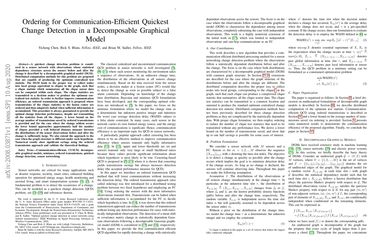Ordering for Communication-Efficient Quickest Change Detection in a Decomposable Graphical Model
A quickest change detection problem is considered in a sensor network with observations whose statistical dependency structure across the sensors before and after the change is described by a decomposable graphical model (DGM). Distributed computation methods for this problem are proposed that are capable of producing the optimum centralized test statistic. The DGM leads to the proper way to collect nodes into local groups equivalent to cliques in the graph, such that a clique statistic which summarizes all the clique sensor data can be computed within each clique. The clique statistics are transmitted to a decision maker to produce the optimum centralized test statistic. In order to further improve communication efficiency, an ordered transmission approach is proposed where transmissions of the clique statistics to the fusion center are ordered and then adaptively halted when sufficient information is accumulated. This procedure is always guaranteed to provide the optimal change detection performance, despite not transmitting all the statistics from all the cliques. A lower bound on the average number of transmissions saved by ordered transmissions is provided and for the case where the change seldom occurs the lower bound approaches approximately half the number of cliques provided a well behaved distance measure between the distributions of the sensor observations before and after the change is sufficiently large. We also extend the approach to the case when the graph structure is different under each hypothesis. Numerical results show significant savings using the ordered transmission approach and validate the theoretical findings.
PDF Abstract
